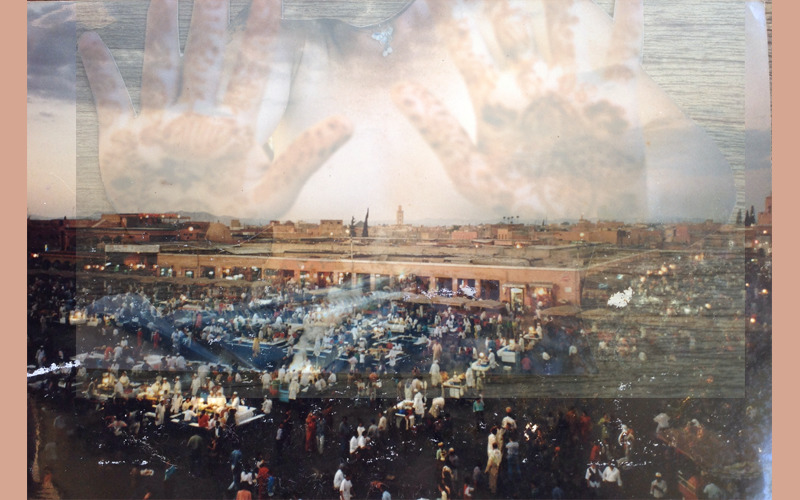HOW DID YOU GET INTO HENNA?
Possibly my most frequently asked question; that and “How long have you been doing this?”.
In 1996, Drew, my husband, and I hitch-hiked from Paris to Morocco. We were young, full of bravado and on a shoestring budget. We knew nothing much about Morocco, except that we wanted to get there. Some of our friendly rides offered ideas of places to go: mainly avoid the northern cities and head straight to Chefchaouen in the Rif Mountains of the north-east. This we successfully did, with a little help from our friends – our first and only hitch in Morocco was a Spanish couple with a VW van who we approached at the border town of Ceuta. They were heading there directly and took us to their favourite pension. Chaouen was our introduction to Morocco, and what a sweet one it was. It’s misty in the mountains with fresh, cool air and a powerful spring that supplies the towns water. Mint Tea here was absolutely the best in the country. We had planned to stay for a couple of days, but rested for a week.
One afternoon I saw a young Spanish woman in the street, her arms covered with dark brown patterns, like lace gloves. I was instantly amazed and intrigued, couldn’t take my eyes off them! A few days passed and I finally asked someone about this artwork I’d seen; the young man led me through the woven streets – up and down and around and over and under. I had no idea where I was and laughed out loud at the fantastic, non-linear world they inhabit. We arrived at a small gate and home – glowing in shades of pale beautiful blue – of an older lady who could henna. As it turns out, the price I was told seemed more than I could spare; we had such little money, anything above simple food and a ticket to the next town did not seem possible.
Had I known my life ahead was to embody henna so fully, I would have made the stretch! Of course, the longing for henna stayed with me and I knew I would get some at the next opportunity. After a bus to Fez and the slow train to Marrakech, amongst the classic mayhem that is Place Jemaa el Fna, we saw henna again. From my diary:
Monday 16th September 1996
Entertained and fed in Jemma el Fna, “the end of the world” or “place of the dead”.
Full of Life; non-stop, continual, ever-changing life.
Musicians and juice stalls are constant, but others come and go as they are needed.
Shoe Polishers are abundant early in the day catching those on their way to work.
Bread comes out as it is baked, a permanent row of small bread ‘huts’ fill and competitive owners sit side-by-side.
Snake taunters, nut stalls, medicine men, women with colourful knotted hats, fossils, potions and gimmicks.
And as that rose-red city glows in the sunset pink, up fire the food stalls en mass.
Snail soup, harira, boiled meat hacks, tomato salads, roasted capsicum, sliced eggplant, couscous, vegetable tajine, chickpeas, fish, chicken stews, meat kebabs and tea with high intensity spice cakes to finish. All stalls working extremely hard for your business.
Crowds, the place is full, buying, moving.
My hand is grabbed. A woman, veiled in disguise, wants to decorate my hands with henna. Very insistent and states a very high price. We compromise and I sit thrilled and entranced by what she’d doing. She gives Drew’s arm a butterfly.
Although it was fast work, the imagery and style, later interpreted for me in the Atlas Mountains were typical Moroccan symbols. I felt satisfied even though this experience was quite opposite from the intimate and calm one I had passed up with the old lady in her home in the Rif Mountains.
So, here it is, where my wondrous journey with this plant began. Before traveling to Morocco, I had been studying a BA in Art History and Anthropology, which needed completing on our return – one subject to go! We moved to the rainforest near Kuranda, Far North Queensland, completed studies, worked in an art gallery and had a baby. Part time work with the Kuranda Arts Co-operative had to stop when little Lily began to crawl – the sculptures were not safe. At this time I saw a book for sale in the Cairns bookstore called ‘The Art of Mehndi’ by Sumita Bahtra, and the memory of our love for henna, with thoughts to bring it back to Australia, resurfaced. I bought the book and decided that’s what I was going to do: be a henna artist. Fortunately, our good friends, Kym and Belle, let us draw on them for practice as we prepared our first stall for Woodford Folk Festival – that was 1999/2000; we have been there every year since!


